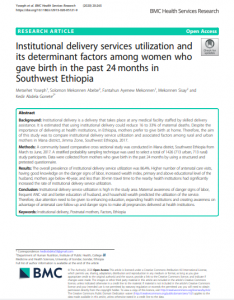
Background
Institutional delivery is a delivery that takes place at any medical facility staffed by skilled delivery assistance. It is estimated that using institutional delivery could reduce 16 to 33% of maternal deaths. Despite the importance of delivering at health institutions, in Ethiopia, mothers prefer to give birth at home. Therefore, the aim of this study was to compare institutional delivery service utilization and associated factors among rural and urban mothers in Mana district, Jimma Zone, Southwest Ethiopia, 2017.
Methods
A community based comparative cross sectional study was conducted in Mana district, Southwest Ethiopia from March to June, 2017. A stratified probability sampling technique was used to select a total of 1426 (713 urban, 713 rural) study participants. Data were collected from mothers who gave birth in the past 24 months by using a structured and pretested questionnaire.
Results
The overall prevalence of institutional delivery service utilization was 86.4%. Higher number of antenatal care visits, having good knowledge on the danger signs of labor, increased wealth index, primary and above educational level of the husband, mothers age below 40-year, and less than 30-min travel time to the nearby health institutions had significantly increased the rate of institutional delivery service utilization.
Conclusion
Institutional delivery service utilization is high in the study area. Maternal awareness of danger signs of labor, frequent ANC visit and better education of husband, and household wealth predicted the utilization of the service. Therefore, due attention need to be given to enhancing education, expanding health institutions and creating awareness on advantage of antenatal care follow up and danger signs to make all pregnancies delivered at health institutions.